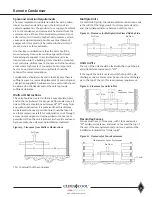
23
www.climacoolcorp.com
It is imperative that the water systems are free from debris
prior to initial operation (see Water Treatment for
a comprehensive list of precautions on page 24) .
Filling, Purging and Leak Testing the System
After the water systems have been properly installed,
visually inspect all joints for tightness . If the chiller is to be
installed in an existing system, the cleanliness of the existing
system can be judged from the operating conditions of the
present machines . The cooling tower in particular, should
be inspected and cleaned, if required . It is good practice to
flush and, ideally, to acid wash the existing system
before
connecting a new chiller .
The following method is recommended to fill and leak check
the water system for modules
WITH
water isolation valves:
1 .
Close all water isolation valves inside each module which
isolate the individual heat exchangers .
2 .
Ensure that all drain valves are closed and that all water
main isolation valves are opened .
3 .
The system should be filled with clean water sent
through the strainers and the system checked for leaks .
4 .
Once the main water lines and the chiller headers are
filled with clean water, purge and repeat the filling
process at least three times .
5 .
All modules are equipped with ¾” fill and flush valves
with lines that tee into the inlet and outlet connections
into and out of each heat exchanger . Ensure these ¾”
valves are
CLOSED
.
6 .
Open the water isolation valves inside each modular
chiller and repeat the filling process, this time also
checking for leaks inside each module .
7 .
Following the final filling and leak checking procedure,
air should be purged from the system .
The following method is recommended to fill and leak
check the water system for modules
WITHOUT
water
isolation valves:
1 .
Ensure that all drain valves are closed .
2 .
All modules are equipped with ¾” fill and flush valves
with lines that tee into the inlet and outlet connections
into and out of each heat exchanger . Ensure these ¾”
valves are
CLOSED
.
3 .
The system should be filled with clean water sent
through the strainer and the system checked for leaks .
4 .
Once the main water lines and the chiller headers are
filled with clean water, purge and repeat the filling
process at least three times .
5 .
Following the final filling and leak checking procedure, air
should be purged from the system .
Cleaning the System
The following method is recommended to properly clean
the water systems:
1 .
Before cleaning the system, install a temporary bypass
line between the main supply and return water headers
of both chilled and condenser water systems when
possible . Open the main header bypass lines to divert the
initial water flow around the module heat exchangers
until operator is confident the circulating water is mostly
pure .
2 .
Provided main header bypass lines are installed, close all
water isolation valves inside all modular chillers equipped
with manual or automatic water isolation valves . If the
modules are NOT equipped with water isolation valves,
ClimaCool recommends installing 3-way main header
bypass valves so the initial water flow bypasses all
module heat exchangers .
3 .
It is mandatory to run the pumps with the strainers in
place (see Starting the Pumps section below for proper
pump startup) . All external hydronic branches should be
open to all devices in the system .
4 .
Pressure drop across the strainer must be observed
and as pressure change reaches 50% of the initial read,
strainers must be isolated and cleaned .
5 .
Open all water isolation valves inside each module
equipped with manual or automatic water isolation
valves (see step 6 for modules NOT equipped with water
valves) . If bypass lines are not installed (described in step
1), it is recommended to drain out the initial fill of water
to help flush out debris. Close off the main header bypass
lines referred to in step 1 and open the flow to the main
water headers . Repeat steps 3 and 4 until there is no
more debris being collected by the strainers .
6 .
If bypass lines are not installed (described in step 1) and
the modules are NOT equipped with water isolation
valves, it is recommended to drain out the initial fill of
water to help flush out debris. Remove and clean the
strainers before refilling and purging the system again.
Repeat steps 3 and 4 until there is no more debris being
collected by the strainers .
Starting the Pumps
Follow the manufacturer’s recommendations when starting
the pumps for the first time. The system should be checked
for leaks and air purged with the pumps in operation . The
pressure drop across the heat exchangers will give a good
indication of flow through the system (see Evaporator
Water Pressure Drop Charts on page 26) . This should be
immediately checked against the expected pressure drop
for the flow rate required.
If the pressure drop begins to fall
and the flow rate is falling, this could indicate the need to
clean the strainers.
Filling the Water System
Summary of Contents for CLIMACOOL UCR 30
Page 19: ...17 www climacoolcorp com Voltage Phase Monitor Wiring Diagram...
Page 29: ...27 www climacoolcorp com Evaporator Water Pressure Drop Charts...
Page 30: ...28 www climacoolcorp com Glycol Performance Adjustments Factor Charts...
Page 78: ...76 www climacoolcorp com Wiring Diagram...
Page 79: ...77 www climacoolcorp com Wiring Diagram...
Page 80: ...78 www climacoolcorp com Wiring Diagram CoolLogic Control Panel...
Page 81: ...79 www climacoolcorp com Wiring Diagram CoolLogic Control Panel...
















































